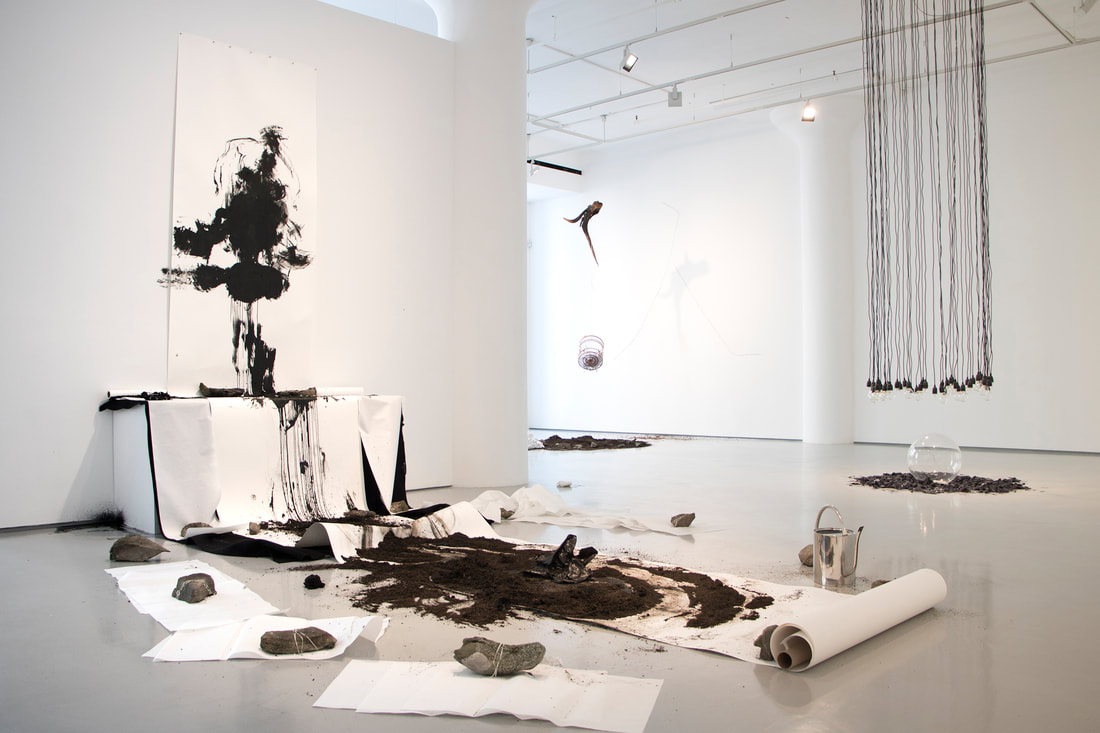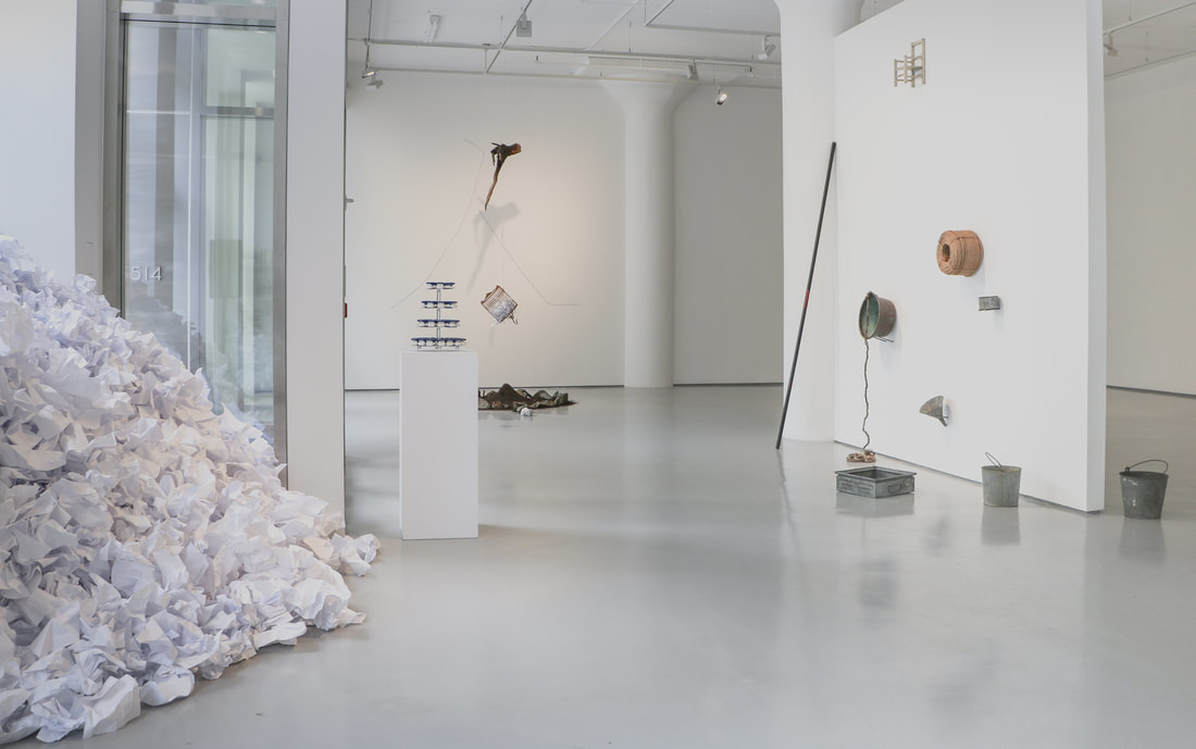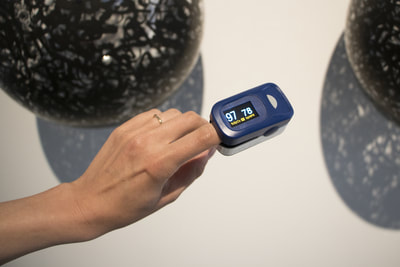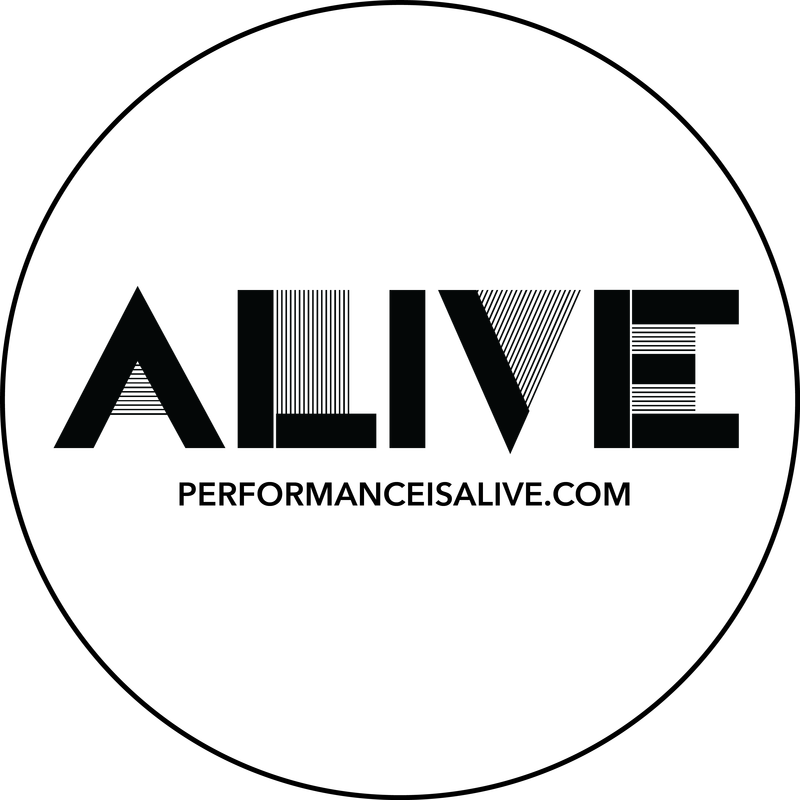|
REMAINS PROVES PERFORMANCE ART STILL HAS A PULSE Fergus McCaffrey, NYC, July 2017 By Ian Deleón To use the word remains is to invoke in someone associations with death, decay, and possibly even dismemberment. Generally speaking it refers to the parts left behind, once some significant change in status has taken place. That change is usually framed in terms of a negative, destructive event but of course destruction can be a kind of creation as well. The word’s linguistic ties to remaining mean that it can also convey that which lives on, or that which stays put. In relation to the art of live performance, talking in terms of remains certainly articulates some of the finer points about post-action detritus and extended duration times, but it’s also important to address the aspect of performance art’s own supposed untimely demise. The notion that one art form or another has died at some point is pervasive in contemporary art historical discourse. Painting has died so many times it has spawned zombie movements. But that kind of makes sense, painting was old. But performance art is fairly new...at least, by some accounts. When we talk about performance in this article we may concede to the influence of its antecedents: of the theater, of dance, of magic, of cinema, of protest. But performance art cannot be all of those things if we are going to have a productive conversation about it. It has to be its own thing, while often appearing in the guise of those other art forms. Performance wasn’t a flash in the pan either, with its death knell rung by an explosion of consumer culture, information, communication or globalization in the early 90s...NO. Performance Art is NOT dead and this exhibition is the proof––the exhumation, the surprise discovery that the remains are intact...and ALIVE. Dirt, stones, aluminium and shattered glass strewn across a polished concrete floor. An up-turned steel bathing tub, half sawn through, glowing from within. A crown of thorns and a cracked acrylic globe pushed off the wall. A streak of black ink across a long white scroll. A smear of vaseline and a sprinkling of spittle and coffee along a thick, flat sheet. This is what remained as of the third day of live performances inside Fergus McCaffrey gallery’s newest show. Curated in-house by the gallery’s own exhibitions coordinator Tif Robinette, REMAINS (on view from July 6 - August 11, NYC) is in many ways a heart-stopping departure for the Chelsea stalwart. Known for its impressive blue chip displays of Gutai action-paintings––themselves often products of elaborate live performances––Robinette was able to make a strong case for the gallery to take a unique role in supporting the work of contemporary artists of a similar vein. In her estimation, as a curator of contemporary performance in Brooklyn during her off hours, plenty of artists are still making the kind of exciting live work everyone remembers or has heard of from the 1970s and 80s, but the allocation of resources for this kind of work has drastically changed. Naming is part of the problem. These days, hardly anybody can agree on what performance art even is, especially how it differs from the performing arts or some devious act of trickery. The symbolic use of timing, the intense concentration, and frankly, the bravado of canonical performance art has left an indelible and unfortunate mark on the popular consciousness. Acts as conceptually and ethically disparate as Joaquin Phoenix’s faux retirement, Voina’s public orgy and even terrorist hijackings have been regarded under the same phenomenological rubric and given equal weight as “performances”. While intellectually stimulating, these kinds of comparative exercises don’t do fine arts practitioners any favors. On the other side of the coin is dance, which has in recent years become the go-to par excellence for museums hoping to engage an audience with a relatively safe live art experience. More and more grants and opportunities have gone the way of re-branded contemporary dancers, but the inverse has not been true. Often dogmatically opposed to defining itself, the performance art community as such lives on the periphery of the periphery, with many asking themselves: “besides the remote possibility of winning a Franklin Furnace, whadda we got?” Galleries are usually no better. Whether they’re peddling out the same stagnant documentation from the golden years or staging some celebrity-baiting relational happening, engagement with performance art at for-profit institutions tends to be a disappointing experience for those of us who frequent the “dingy venues” of the Brooklyn/Queens underground. But has the world changed or have I changed? Have galleries completely lost their courage or has performance art, mired in its own democratization, largely de-skilled itself into extinction? Both may be true. Hee Ran Lee, Liping Ting, Máiréad Delaney, Daniel Neumann, Nigel Rolfe, and Clifford Owens are literally the kind of artists that you overhear people talking about this way: “It made me want to do performance art!” Selected by curator Robinette for their winning combination of “conceptual rigor, commanding stage presence and material sensibilities”, these six artists will over the course of the summer create and present a staggering number of new and site-specific work just for this context. All of the artists are approaching the idea of mark-making in their own distinct fashion, weighing the history of literal, gestured marks and the importance our species accords them against the idea of the marks we make on life––whom or what gets left behind. For the preview event of the exhibition, Clifford Owens, arguably the most recognizable name on the list of participating artists, did a really smart thing––he blindfolded us. He also made it clear that he did not want there to be an photography during his piece. If, reading this, you have already begun to feel a bit deflated, don’t worry, you wouldn’t have been alone. Dividing the audience into groups depending on how they answered his question “do you trust me?”, Clifford seemed amused to notice at least one person from the gallery’s staff on the “no” side. But anticipation and expectation are precisely what Clifford is most adept at handling. Once he’s got the audience blindfolded and seated on the floor around a stretched piece of heavy stock paper, Clifford surprises us with the sound of someone spitting. Heightened spatial awareness lets me know I was being assailed from multiple sides––there were at least two people spitting, and I could feel it hitting me from time to time. As a performer myself, I was thrilled to have Clifford taking me on such an unexpected ride, but I can easily imagine the frequent maniacal laugh escaping the artist’s mouth after a particularly satisfying expectoration to be causing a mild sense of discomfort in some of the other attendees. If this were a magic act, the next part of the performance would be called “The Turn”––when the ordinary becomes extraordinary. We hear a tin can go rattling across the length of the concrete gallery floor and then like riding the crest of a giant wave, we’re slowly engulfed on the shore by the crashing aroma of ground coffee. Café Bustelo to be exact––completely transforming the psychological space around us, allowing my mind to create the most lush, vivid brushstrokes of longing, desire, and melancholy. Clifford continued issuing directions to someone(s) as I lost myself in thought for several minutes. Eventually pulling free, I was surprised to realize we were sitting in silence. Everything around me had stopped and no one was shuffling, just the sounds of rhythmic breathing. It was like that immediate shift in consciousness that comes at the end of a hallucinogenic trip. Then, all of a sudden, Clifford broke the silence, and gave us all permission to remove our blindfolds. Like children emerging from a damp cave, some of us pulled the blinds off cautiously, squinting up at the harsh fluorescent lights, almost afraid to step off our perceptual precipice. It took me a moment to remember how to use language so that I might begin to describe to myself the sight in front of us. Clifford has gone, and standing at opposite ends of the composition on the floor are two completely nude attractive white men in their 20s. One of these men selected by Clifford, was performance virgin Will Martin, who remarked later that the experience of being nude in public in that way was “surprising”. Expecting to feel shame and embarrassment, WIll actually felt “fearless” and “in control”. Before the two men lies a topographical psychoscape of spittle and coffee, which would reach its full maturation at the end of the performance. But for now, we are summoned upstairs. Clifford’s disembodied voice beckons us to another location––I’m still mystified at the fact that I haven’t seen him for such a long time during this performance. I feel like I’m watching an illusionist, someone who understands the artful application of live magic’s key component––misdirection. 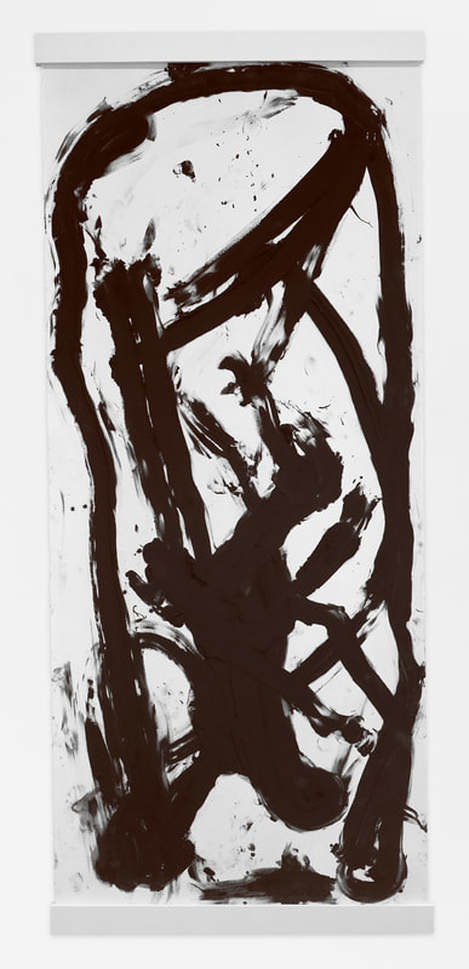 Clifford Owens Untitled, 2017, REMAINS at Fergus McCaffrey, New York, coffee and vaseline on paper 120 x 51 inches (304.8 x 129.5 cm), courtesy of Fergus McCaffrey Clifford Owens Untitled, 2017, REMAINS at Fergus McCaffrey, New York, coffee and vaseline on paper 120 x 51 inches (304.8 x 129.5 cm), courtesy of Fergus McCaffrey I could persist here and go on telling you about the rest of the performance, but I’d like to think that Clifford would appreciate me borrowing a little bit of his flair for the mysterious in this case. I’ll conclude this section by remarking that in this performance and another one that has come to pass since, the African-American artist continues to explore his interest in proxies, surrogates, and stand-ins. The two carefully preserved remains from Clifford’s nuanced entanglement with identity, authorship, and the history of painting were hung after the performance and are now on sale at the gallery for $20,000. Objects, some of us believe, have a secret life all their own. Performance artists, you could say, believe this more than most. For many of them, an object used during live performance becomes elevated, imbued with psychic and emotional resonance. Robinette believes in this energy transference, stating: “Ephemera can jog or help you form a new memory about a performance after the fact. Typically, performance events are over and done with too quickly for objects to develop these secret lives. But if you’re able to spend time with them, they reveal things to you, and you can feel their power growing once you’ve learned how they were used.” This ritual-esque observation is common amongst live artists, especially looking back towards the influence of the shamanistic German “social sculptor” Joseph Beuys, whose powerful live provocations have managed to be successfully represented via the often excruciatingly esoteric juxtapositions he left behind. “I chose these artists specifically because I knew that we would be getting a huge range of materials and aesthetics to work with, from vintage and repurposed to the new and mass produced, even organic. We’re trying to attract new, especially young collectors to this show, who may not have had a chance to see work like this before since galleries rarely show this stuff. We think it can sell––it should sell, the work is really strong. The challenge for us is to keep up with practical tasks like updating price lists and creating new consignment agreements, we literally have new work being added to the show every day!”, exclaims Robinette. Here is what I saw a few days after Clifford’s preview performance: In contrast to his generative way of working, which would lead to the piece being added to the show post-action, Máiréad Delaney created a pair of performances beginning and ending with the violent transformation of an object already arranged in the space as an installation. Situated amongst a variety of other domestic objects in unsettling and compromising configurations, Máiréad’s steel bathtub looked normal enough sitting on top of a waist-high pedestal in the upstairs gallery. This was the official opening night of REMAINS, and an enthusiastic summer crowd had found themselves enticed through McCaffrey’s doors. Liping Ting kicked off the night with an interactive piece that used the entire front entrance of the gallery in a frenzied ritual of rebirth and transformation using natural elements like stones, feathers, and soil. Straight up jazzed from a combination of good weather, free alcohol, and completely unexpected gallery proceedings, I assume that most of this audience was not very familiar with seeing performance art live and in person, but they were damn excited to be getting the opportunity. Their delight was truly palpable thanks to a performative intervention by Hee Ran Lee, whose fingertip-reading pulse oximeters were given out to audience members as they entered the gallery. So when we rounded the stairs and saw Máiréad calmly and intently holding down the space in anticipation of our arrival, the room quickly fell silent save for the intermittent beeps proclaiming the fluctuations of our heart rates. With a controlled and precise demeanor, Máiréad waits for the crowd around her to settle then proceeds to remove her shoes, her pants, and don a pair of work gloves. She begins slowly and methodically to move the large tub, taking it upright against her body and letting it fall over the pedestal again so that the hollow end faces downwards, like a cocoon or casket. Máiréad now grabs an angle grinder and mounts the tub with all the measured fidelity of a familiar, but fraught encounter. Suddenly, that whirring, piercing sound of the blade hitting the steel fills the air and eyes widen as a jet of sparks shoots four feet from the tub, crashing against the pristine white wall––I secretly hope they’re able to leave a mark. Máiréad is of course receiving a steady stream of sparks directly into her own face at this point, which bears no protection, while she powers through the concave belly of the welded body beneath her. Over the course of what would seem like an eternity of flickering showers, with the audience visibly wincing and cringing at her resilience, Máiréad leans into and off of the grinder, making sure that the majority of the sparks are landing squarely between her legs. Afterward, the artist would show me the battered remains of her nylons, clarifying that the sparks are “little bits of cut metal”, which feel hotter the closer they land from their origin point. “Mostly [they] feel like flying grit.” Máiréad returned to the gallery almost one week later and resumed her forensic investigation of the tub pretty much where she left off, though this time to a much less rowdy and more intimate crowd that included her parents. She was conscious of wanting to “de-escalate” elements of spectacle that characterized the first part of the performance. Gone were the sparks, charisma and mechanical sounds from the opening. Now, Máiréad lays her back across the hump of the inverted tub, allowing her head to disappear inside of the widened slit made earlier with the angle grinder. She spends most of the two hours of her performance in this pose, deliberately referencing Louise Bourgeois’ The Arch of Hysteria (1993), a sculpture that recalls the “curved, taut frame associated with Charcot’s Salpêtrière female patients”––its missing head “indicating the absence of reason”. Inside the tub, Máiréad’s mouth grips the edge of the incision, probing the jagged steel contours as water is thrown on her throughout the performance, marking the passage of time. “The face is annihilated but not silenced, the mouth is questioning”, says the artist. For this slow, unnerving action, Máiréad has chosen to embody a “present, active silence” that complicates notions of complicity in relation to narratives of violence.
REMAINS PERFORMANCE DOCUMENTATION |
| ABOUT PERFORMANCE IS ALIVE CONTRIBUTOR // Ian Deleón (b. 1987, Miami) holds an AA in English Literature from the Miami Dade College Honors Program and a BFA from the Studio for Interrelated Media (SIM) at the Massachusetts College of Art & Design, Boston. He currently lives and works in Brooklyn, NY with his wife Tif Robinette. Together they are the curators at PULSAR Performance. |
CONTRIBUTORS
Ian Deleón
Quinn Dukes
Alexandra Hammond
Luke Mannarino
Polina Riabova
Sarah G. Sharp
Alex Sullivan
Archives
July 2023
August 2022
November 2021
October 2021
September 2021
May 2021
March 2021
January 2021
December 2020
November 2020
September 2020
April 2020
January 2020
December 2019
November 2019
October 2019
September 2019
August 2019
July 2019
June 2019
April 2019
March 2019
February 2019
December 2018
November 2018
October 2018
September 2018
August 2018
July 2018
June 2018
May 2018
April 2018
March 2018
February 2018
January 2018
November 2017
October 2017
September 2017
July 2017
June 2017
May 2017
April 2017
March 2017
February 2017
January 2017
November 2016
September 2016
July 2016
June 2016
May 2016
April 2016
March 2016
February 2016
January 2016
December 2015
November 2015
October 2015
September 2015
August 2015
July 2015
June 2015
May 2015
April 2015
March 2015
February 2015
January 2015
December 2014
November 2014
